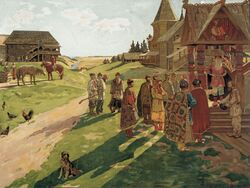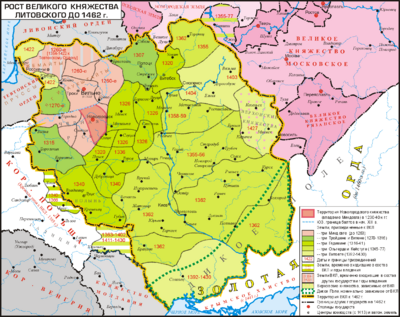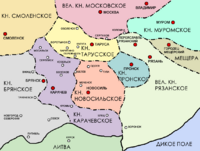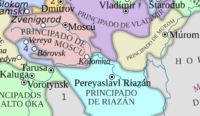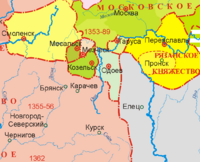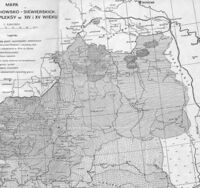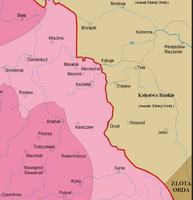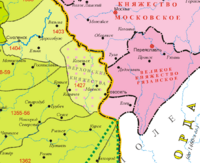إمارات أعالي الأوكا
In Russian historiography the term Upper Oka Principalities (روسية: Верховские княжества, romanized: Verkhovskie knyazhestva, lit. 'Upper Principalities') traditionally applies to about a dozen tiny and ephemeral polities situated along the upper course of the Oka River at the turn of the 14th and 15th centuries.[بحاجة لمصدر] They were reigned by the "upper princes", each of which descended from Mikhail Vsevolodovich of Chernigov (Grand Prince of Kiev c. 1236–1243).[1] Nowadays, the areas concerned lie within the bounds of the Tula Oblast, Kaluga Oblast, Oryol Oblast and Bryansk Oblast of the Russian Federation.[بحاجة لمصدر]
Following the Mongol invasion of Kievan Rus' of 1223–1240, the formerly prominent Olgovichi clan of the Principality of Chernigov gradually declined to a point where the descendants of Mikhail of Chernigov (died 1246) ruled dozens of quasi-sovereign entities.[بحاجة لمصدر] As the principalities were wedged in between the ever-expanding Grand Duchy of Lithuania to the west and the nascent Principality of Moscow to the north, their rulers were constricted to continually fluctuate between these two major powers as buffer states.[1]
By the end of the 14th century, they were obliged to pay annual tribute to Lithuania.[بحاجة لمصدر] The strengthening alliance of Lithuanian rulers with Roman Catholic Poland caused shifts in the balance of power in the region. Most Orthodox rulers of the Upper Oka Principalities, therefore, started to look to Moscow for protection against Lithuanian expansionism.[بحاجة لمصدر] Others sought Lithuanian protection against Muscovite aggression, such as Prince Ivan of Mozhaysk who in 1454 fled to Lithuania to escape from Vasily II of Moscow.[2] Towards the end of the 15th century, most of these princelings had moved to the Muscovite court. In 1494 Lithuania finally renounced her claims to the region.[بحاجة لمصدر]
بين موسكو ولتوانيا
مع امتداد سلطة گراندوقية لتوانيا إلى إمارة بريانسك في 1357، the princes of which usually held the title of Grand Dukes of Chernigov, the Verkhovsky principalities began to experience the influence of Moscow and Lithuania, and by the end of the 14th century, Ryazan . In 1375 - 1380 they acted in alliance with the Principality of Moscow in the campaign against Tver and in the Battle of Kulikovo . But already at the beginning of the 15th century they also became dependent on the Grand Duchy of Lithuania, which was paid the so-called “lete” (that is, an annual tribute ).
Some of these principalities completely fell under the rule of the Grand Duchy of Lithuania and lost their independence, but some completely retained internal autonomy and their ruling dynasties even after joining it. Thus, in the second half of the 15th century, although the Vorotyn , Odoevsky and Belevsky principalities were under Lithuanian jurisdiction, the Grand Duke of Lithuania Casimir did not interfere in their internal affairs and only sometimes demanded participation in military operations.
Each principality was divided between the heirs-brothers into parts (“dolnitsa”). The successes of the Grand Duke of Moscow Ivan III in the fight against the Horde contributed to the “departures” of the Verkhovsky princes for Moscow service, which led to the Border War of 1487-1494 . As a result, under the treaty of 1494, the Grand Duchy of Lithuania was forced to recognize the inclusion of these lands (except for Karachev) into the Russian state .
The name “Verkhovsky principalities” in historical literature is applied to all former Chernigov fiefs on the upper Oka, however, in sources of the 15th century only the fiefs of the disintegrated Novosilsk principality are called Verkhovsky . [15] Some of their number ( Vorotynskoye , Odoevskoye ) remained as appanages even after inclusion in the Russian kingdom until 1573 .
قائمة الإمارات (بترتيب الأقدمية)
- Odoyev (Principality of Odoyev) and Novosil[1] - the seats of the Odoyevsky princes,[1] retained by them as an appanage until the Oprichnina of 1565-1572
- Belyov (or Belev;[3] Principality of Belyov) - the seat of the Belyovsky princes[1] (1468-1588)
- Vorotynsk - the seat of the Vorotynsky princes,[1] retained by them as an appanage until the Oprichnina
- Mosalsk - the seat of the Mosalsky princes[1]
- Zvenigorod on the Oka - the seat of the Zvenigorodsky princes[1] and the Nozdrevaty princes[بحاجة لمصدر]
- Karachev - the seat of the Khotetovsky princes
- Kozelsk and Peremyshl - the seats of Princes Gorchakov
- Tarusa (Principality of Tarusa or Torusa)[1] and Meshchevsk (now Meshchovsk) - the seats of Princes Mezetsky with their cadet branches of Teterin, Shcherbatov
- Boryatino - the seat of Princes Boryatinsky
- Obolensk - the seat of the Obolensky princes[1] with their cadet branches of Repnin, Lykov, Dolgorukov, Shcherbatov, etc.
- Upper Oka Principalities ح. 1350
- Upper Oka Principalities in 1389Principality of KozelskPrincipality of Masalsk
Upper Oka Principalities ح. 1400
- Upper Oka Principalities in 1434Vassals of the Golden Horde
- Upper Oka Principalities in 1462
References
- ^ أ ب ت ث ج ح خ د ذ ر Rusyna 2003, p. 494.
- ^ Martin 2007, p. 340–341.
- ^ Martin 2007, p. 268.
ببليوجرافيا
- Bazilewicz K.V. Foreign Affairs of the Russian Centralized State. Moscow, 1952.
- Lubawski M.K. Regional Division and Local Administration in the Lithuanian-Russian State. Moscow, 1892.
- Martin, Janet (2007). Medieval Russia: 980–1584. Second Edition. E-book. Cambridge: Cambridge University Press. ISBN 978-0-511-36800-4.
- Rusyna, Olena Volodymyrivna (2003). "Верховські князі" [Upper princes]. Encyclopedia of History of Ukraine. Volume 1 (in الأوكرانية). Kyiv: Institute of History of Ukraine. p. 494. ISBN 966-00-0734-5. Retrieved 20 February 2024.
- Short description matches Wikidata
- Articles containing روسية-language text
- Pages using Lang-xx templates
- مقالات ذات عبارات بحاجة لمصادر
- CS1 الأوكرانية-language sources (uk)
- Russia articles missing geocoordinate data
- All articles needing coordinates
- Historical regions in Russia
- Former principalities
- States and territories established in the 14th century
- Olgovichi family
